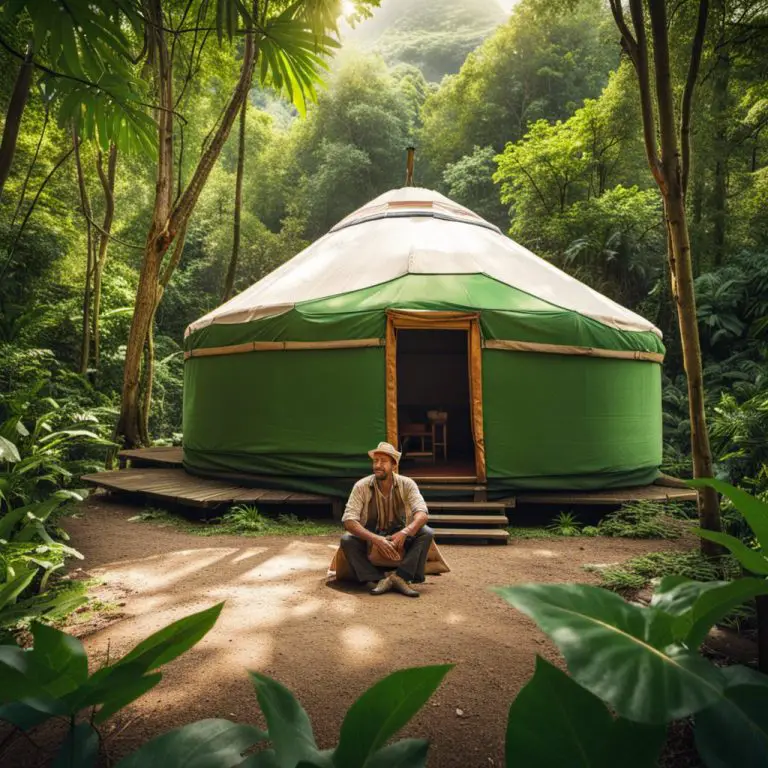Does a Yurt Have to Be Round? Exploring the Shape and Design of Traditional Yurts
A yurt is a traditional nomadic dwelling that has been used for centuries in Central Asia. It is a circular tent-like structure that is easy to assemble and disassemble, making it ideal for those who need to move frequently. However, many people wonder whether a yurt has to be round.
The answer is no, a yurt does not have to be round. While the traditional yurt is circular, there are other shapes and designs available. For example, a ger is a similar structure that is more conical in shape, with a pointed top instead of a rounded one. Additionally, there are yurts that have tapered walls or a frame panel design, which can be square or rectangular in shape.
When it comes to using a yurt as a home or structure, the shape and design can have an impact on its functionality. For example, a round yurt may be more energy-efficient because there are no corners for heat to escape from. However, a square or rectangular yurt may be easier to furnish and decorate, as it has more defined spaces. Ultimately, the shape and design of a yurt will depend on the individual’s needs and preferences.
Yurt Design and Construction
Materials and Insulation
Yurts are traditionally constructed using a circular lattice frame made of wood, which is then covered with fabric, felt, or canvas. Modern yurts, however, can be made of a variety of materials, including metal and plastic. The walls of a yurt can be insulated with layers of wool or other materials to provide warmth and protect against the elements.
Shape and Space Efficiency
The circular shape of a yurt provides a unique and efficient use of space. The circular design allows for a more open and spacious interior, while also providing strength and stability. The lattice walls of a yurt can be easily adjusted to accommodate different room layouts, making it a versatile living space.
Building Process
The construction of a yurt can be done in a variety of ways. Some yurts are designed to be nomadic and portable, while others are built as permanent structures on a raised platform. The building process typically involves setting up a door frame, building the lattice walls, and then adding the roof. The use of a raised platform can provide additional insulation and protection from the elements.
In conclusion, a yurt does not have to be round, but the circular shape provides a unique and efficient use of space. The construction of a yurt can be done with a variety of materials and insulation options, and the building process can be adjusted to meet individual needs and preferences.
Cultural and Practical Significance
Historical Background
Yurts, also known as gers, have been used as homes by nomads in Central Asia, particularly Mongolia, for thousands of years. They were traditionally made from materials readily available in the area, such as felt and wood, and were designed to be easily assembled and disassembled for transportation. The circular shape of the yurt was ideal for bracing wind, and the materials used provided protection from harsh weather conditions.
Adaptations and Uses
Over time, yurts have been adapted for use in different contexts and environments. Today, yurts are used for a variety of purposes, including camping, offices, schools, and even homes. Pacific Yurts, a company based in North America, has popularized the use of yurts as alternative homes, offering customizable options for those looking for a unique and sustainable living space.
Environmental Considerations
Yurts are often considered to be an environmentally friendly housing option due to their use of natural materials and efficient use of space. They can be designed to be off the grid, using solar panels or other alternative energy sources for power. Additionally, yurts can be built with minimal impact on the land, making them a popular choice for those looking to live in harmony with nature.
In conclusion, while the circular shape of the yurt is a defining characteristic, it is not necessarily a requirement. The cultural and practical significance of the yurt lies in its adaptability and versatility, making it a unique and sustainable housing option for those looking to live in harmony with nature.
Frequently Asked Questions
What are the structural requirements for a yurt?
Yurts are typically round and consist of a lattice wall, a roof ring, and a central compression ring. The wall and roof are covered with a waterproof material, such as canvas or vinyl. The circular shape of the yurt provides structural integrity and stability, allowing it to withstand high winds and heavy snow loads.
Can yurts be constructed in non-traditional shapes?
While yurts are traditionally round, they can be constructed in non-traditional shapes such as square or rectangular. However, it is important to consider the structural integrity of the yurt when considering non-traditional shapes.
What purposes do yurts serve in modern and traditional contexts?
Yurts have been used for centuries by nomadic herding families and are still used today as portable dwellings. In modern contexts, yurts are used as guest houses, home offices, yoga studios, and even as primary residences. They are also used for events such as weddings and festivals.
How do the materials and design of a yurt affect its durability?
The materials and design of a yurt can greatly affect its durability. High-quality materials such as heavy-duty canvas and sturdy lattice walls can increase the longevity of a yurt. Additionally, proper design elements such as adequate ventilation and insulation can prevent moisture buildup and mold growth, increasing the yurt’s durability.
What are the main differences between yurts and other portable dwellings?
Yurts differ from other portable dwellings such as tents and RVs in their structural design. Yurts are typically round and have lattice walls, while tents are usually rectangular and have flexible walls. RVs have a rigid structure and are designed for road travel. Yurts also offer a unique living experience, with a spacious and open interior that provides a connection to nature.
What should be considered when purchasing a yurt for residential use?
When purchasing a yurt for residential use, it is important to consider factors such as the size of the yurt, the materials used, and the location of the yurt. It is also important to research local building codes and regulations to ensure that the yurt is compliant with local laws. Additionally, it is important to consider the cost of utilities and maintenance when living in a yurt full-time.












